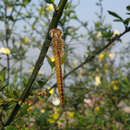Diagnostic Description
(
Inglês
)
fornecido por Odonata LifeDesk
The hind wing has a large anal vein expansion at the base of the wing. Eyes are greyish in colour and females have yellow coloured abdomens. Pterostigmata have trapezoidal shape. Larvae have long lateral spines on the ninth abdominal segment. Setae are present on the larval palpal teeth. The teeth are prominent. Larval wing pads are parallel, and there are no dorsal hooks present on S4-S8. Larval eyes are located above the occiput.
- licença
- cc-by-nc
- direitos autorais
- Ware, Jessica
Ecology
(
Inglês
)
fornecido por Odonata LifeDesk
These dragonflies have been found in unique places, often at bizarre, unpredictable times. There are reports of sudden swarms arriving on Easter Island (Corbet, pers. comm.) or of specimens landing on cruie ships in the middle of the ocean. These dragonflies presumably are moved around quite a bit by the wind, but they are also considered to be strong fliers. They are one of a few "migratory" dragonflies.
- licença
- cc-by-nc
- direitos autorais
- Ware, Jessica
General Description
(
Inglês
)
fornecido por Odonata LifeDesk
Pantala flavescens, or wandering glider, is a cosmopolitan dragonfly present on every continent but Antarctica. This ubiquitous dragonfly is common in most dragonfly collections. Medium sized, it's easily recognized by its colouration and the trapezoidal shape of its pterostigma.
- licença
- cc-by-nc
- direitos autorais
- Ware, Jessica
Life Cycle
(
Inglês
)
fornecido por Odonata LifeDesk
Mainly found in the intertropical convergence zone, Pantala is believed to "migrate", possibly with rain fronts (Corbet 1983, 1988). Pantala flavescens breeds in shallow, and sometimes temporary pools (Askew 1988, Corbet 1988). Larvae are known to consume tadpoles (Sheratt and Harvey, 1989).
- licença
- cc-by-nc
- direitos autorais
- Ware, Jessica
Reproduction
(
Inglês
)
fornecido por Odonata LifeDesk
Females oviposit exophytically.
- licença
- cc-by-nc
- direitos autorais
- Ware, Jessica

